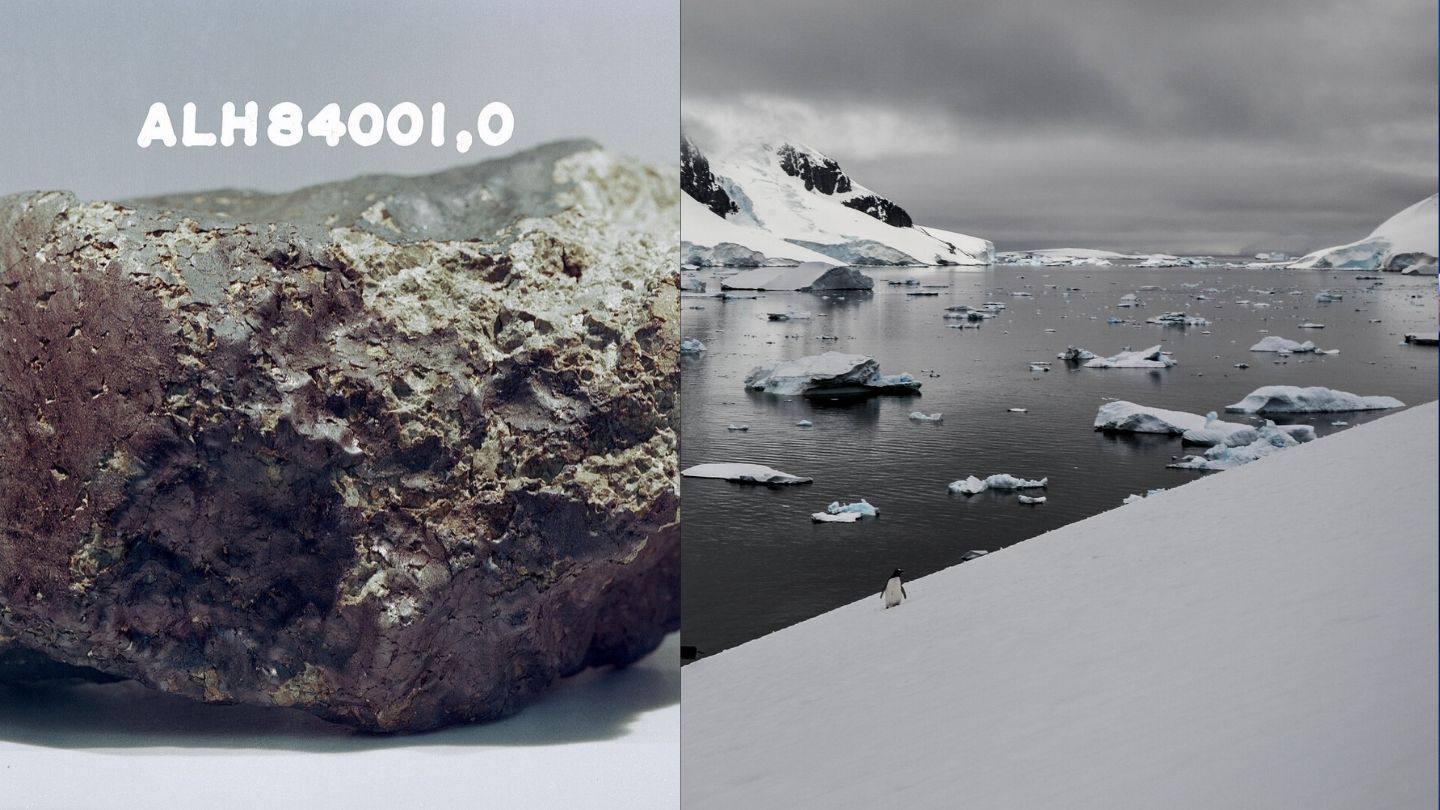A Piece of Mars That Fell in Antarctica Contains Ingredient for Life, Scientists Discover
The new discovery adds to a growing pile of evidence that Mars may have been more hospitable to life in the distant past.
By Becky Ferreira
May 4, 2020,

LEFT: NASA/JSC. RIGHT: FLICKR/DANIEL OBERHAUS
Humans have been chucking robots over to Mars for decades, but occasionally, Mars does us a literal solid by chucking a piece of itself back over to Earth. In 1984, for instance, scientists discovered a four-pound meteorite from Mars in the Allan Hills region of Antarctica, which is known as Allan Hills 84001. Now, scientists have determined that the four-billion-year-old fallen chunk of Mars contains a key ingredient for life.
According to a recent study in Nature Communications, scientists have identified organic compounds containing nitrogen, a vital building block of life as we know it, inside this rare meteorite. This makes it the first time that nitrogen has been detected in a Martian rock dating back to the period when Mars may have hosted an ocean.
A team led by Mizuho Koike, a planetary scientist at Japan Aerospace Exploration Agency (JAXA), used advanced experimental techniques not only to detect this important element, but to confirm it as likely Martian, as opposed to contamination from Earth.
“Understanding the origin of organic material on Mars is a major issue in modern planetary science,” Kioke and his colleagues said in the study. “Recent robotic exploration of Martian sedimentary rocks and laboratory analyses of Martian meteorites have both reported plausible indigenous organic components.”
“However, little is known about their origin, evolution, and preservation,” the team said.
Allan Hills 84001 is a chunk of early Mars, dating back four billion years, which makes it a crucial snapshot of an era when the red planet may have been partly blue due to the presence of a huge sea. Based on its properties, the rock was likely ejected from the subsurface of the planet by a major impact some 17 million years ago. After wandering around in space for several million years, the meteorite crashed into Antarctica about 13,000 years ago.
The rock is a time capsule of a tantalizing era when Mars was likely wetter—perhap enabling it to support life—making it the topic of substantial debate and research.
Allan Hills 84001 caused a stir in the 1990s when scientists suggested that the meteorite contained fossilized bacteria, generating decades of heated debate over the origins and nature of the structures within the rock. While these signs of primitive life remain inconclusive, the new detection of nitrogen-bearing compounds in the meteorite provide an unprecedented look at the nitrogen cycle of early Mars, which is a key system for assessing habitability.
If “considerable amounts and variations of organic matter” were either produced by early geological processes on Mars, or delivered by impacts with other celestial bodies, the nitrogen-bearing compounds might have “a chance to evolve into more complicated forms,” the team said in the study.
Koike and his colleagues identified the Martian nitrogen using an advanced technique called Nitrogen K-edge micro X-ray Absorption Near Edge Structure (µ-XANES) spectroscopy, which is designed to flag extremely subtle traces of this element in compounds. To reduce the risk of nitrogen contamination from Earth, the researchers meticulously isolated microscopic grains from the meteorite and compared them to terrestrial samples found near the rock.
While earthly contamination can not be totally ruled out, the team demonstrated that the nitrogen-bearing compounds “are most likely of Martian origin,” according to the study. While this is not the first detection of Martian nitrogen—NASA’s Curiosity rover has also sniffed out the element on Mars, for instance—it is “the first solid evidence for four-billion-year-old Martian organics containing nitrogen,” according to a statement.
The new discovery adds to a growing pile of evidence that Mars may have been more hospitable to life in the distant past. Nitrogen is an essential cog in the fundamental machinery of all Earthlings: It is present in DNA, RNA, and proteins, and is the main component of the air we breathe. Perhaps it helped bygone Martians emerge billions of years ago, as well.
We will need to send more spacecraft to Mars to better understand its early habitability, especially missions that can bring back more chunks of this neighboring planet to Earth.
“It is expected that additional hidden records of the Martian nitrogen cycle will be acquired by future investigations,” the team concluded, “including a sample return mission from the Martian Moons (Martian Moons eXploration), Mars Sample Return missions, and exploration of the Martian subsurface, as well as further advanced studies of Martian meteorites.”
No comments:
Post a Comment